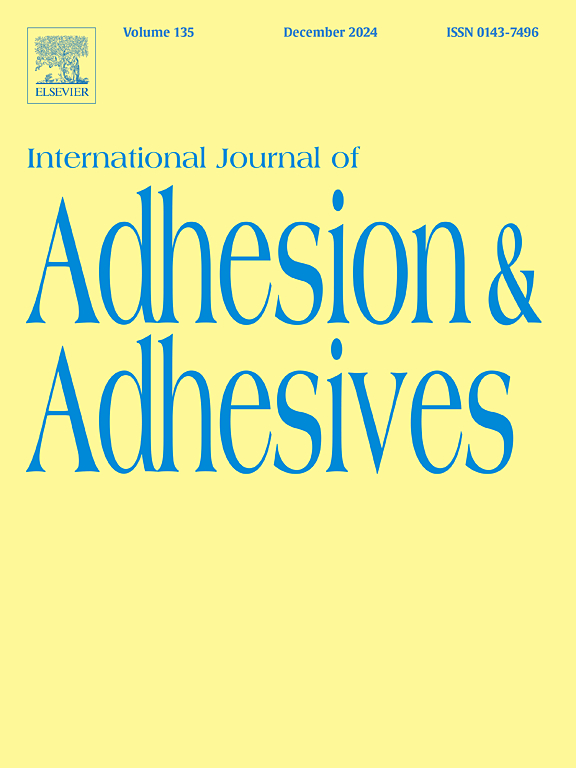Fatigue crack growth analysis of a ductile structural acrylic adhesive under constant-amplitude load control at various loading conditions
IF 3.5
3区 材料科学
Q2 ENGINEERING, CHEMICAL
International Journal of Adhesion and Adhesives
Pub Date : 2025-05-03
DOI:10.1016/j.ijadhadh.2025.104049
引用次数: 0
Abstract
The fatigue behavior of adhesives depends on the type of adhesive and loading conditions. Highly ductile adhesives, such as structural acrylic adhesives, are excellent under static conditions; however, their fatigue crack growth (FCG) is not yet well understood. Especially when ductile adhesives are used to bond large structures, the joints are subjected to cyclic creep, a combination of fatigue and creep. Therefore, it is important to understand the contribution of creep to FCG clearly.
The fatigue double cantilever beam tests of a structural acrylic adhesive were conducted by varying mean loads to investigate the effect of creep on FCG. Calculating the equivalent crack length from compliance, the FCG was found to be divided into three stages, similar to the creep curve. The relationships between FCG rate and energy release rate (ERR) and between ERR and the number of cycles until the FCG onset, i.e., the FCG relationship and G−N curve, were investigated using several ERR parameters. A parameter , which is a combination of ERRs represented by and , was found to be the most suitable crack driving force, and was therefore used to discuss fatigue and creep contributions. For the adhesive tested, the creep contribution was slightly greater in the load control than in the displacement control. Furthermore, the effect of R ratio on the FCG relationships of and was discussed in relation to the fatigue and creep contributions.
某延性结构丙烯酸胶粘剂在恒幅载荷控制下的疲劳裂纹扩展分析
胶粘剂的疲劳性能取决于胶粘剂的种类和加载条件。高延展性的粘合剂,如结构丙烯酸粘合剂,在静态条件下表现优异;然而,他们的疲劳裂纹扩展(FCG)尚未得到很好的理解。特别是当使用延性胶粘剂粘合大型结构时,接头受到循环蠕变,疲劳和蠕变的组合。因此,清楚地了解蠕变对FCG的贡献是很重要的。采用变平均荷载对某结构丙烯酸胶粘剂进行了双悬臂梁疲劳试验,研究了蠕变对结构丙烯酸胶粘剂的影响。从柔度计算等效裂纹长度,发现FCG分为三个阶段,与蠕变曲线相似。利用几个ERR参数,研究了FCG速率与能量释放速率(ERR)之间以及ERR与循环次数之间的关系,即FCG关系和G−N曲线。由ΔP=Pmax−Pmin和Pmean=(Pmax+Pmin)/2表示的ERRs组合参数GΔP1−γ·Gmeanγ被认为是最合适的裂纹驱动力,因此可以用来讨论疲劳和蠕变的贡献。对于所测试的胶粘剂,在载荷控制下的蠕变贡献略大于位移控制下的蠕变贡献。此外,还讨论了R比对Gmax和ΔG的FCG关系以及疲劳和蠕变贡献的影响。
本文章由计算机程序翻译,如有差异,请以英文原文为准。
求助全文
约1分钟内获得全文
求助全文
来源期刊

International Journal of Adhesion and Adhesives
工程技术-材料科学:综合
CiteScore
6.90
自引率
8.80%
发文量
200
审稿时长
8.3 months
期刊介绍:
The International Journal of Adhesion and Adhesives draws together the many aspects of the science and technology of adhesive materials, from fundamental research and development work to industrial applications. Subject areas covered include: interfacial interactions, surface chemistry, methods of testing, accumulation of test data on physical and mechanical properties, environmental effects, new adhesive materials, sealants, design of bonded joints, and manufacturing technology.
 求助内容:
求助内容: 应助结果提醒方式:
应助结果提醒方式:


